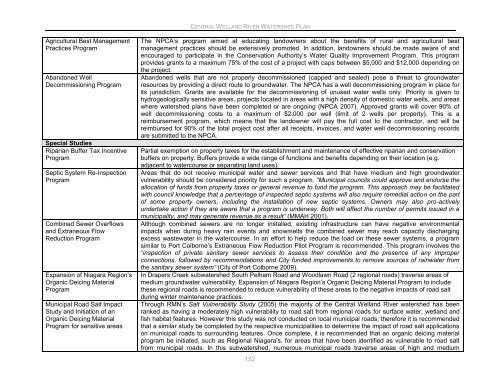Central Welland River Watershed Plan - Niagara Peninsula ...
Central Welland River Watershed Plan - Niagara Peninsula ...
Central Welland River Watershed Plan - Niagara Peninsula ...
- No tags were found...
Create successful ePaper yourself
Turn your PDF publications into a flip-book with our unique Google optimized e-Paper software.
CENTRAL WELLAND RIVER WATERSHED PLANAgricultural Best ManagementPractices ProgramAbandoned WellDecommissioning ProgramSpecial StudiesRiparian Buffer Tax IncentiveProgramSeptic System Re-InspectionProgramCombined Sewer Overflowsand Extraneous FlowReduction ProgramExpansion of <strong>Niagara</strong> Region‟sOrganic Deicing MaterialProgramMunicipal Road Salt ImpactStudy and Initiation of anOrganic Deicing MaterialProgram for sensitive areasThe NPCA‟s program aimed at educating landowners about the benefits of rural and agricultural bestmanagement practices should be extensively promoted. In addition, landowners should be made aware of andencouraged to participate in the Conservation Authority‟s Water Quality Improvement Program. This programprovides grants to a maximum 75% of the cost of a project with caps between $5,000 and $12,000 depending onthe project.Abandoned wells that are not properly decommissioned (capped and sealed) pose a threat to groundwaterresources by providing a direct route to groundwater. The NPCA has a well decommissioning program in place forits jurisdiction. Grants are available for the decommissioning of unused water wells only. Priority is given tohydrogeologically sensitive areas, projects located in areas with a high density of domestic water wells, and areaswhere watershed plans have been completed or are ongoing (NPCA 2007). Approved grants will cover 90% ofwell decommissioning costs to a maximum of $2,000 per well (limit of 2 wells per property). This is areimbursement program, which means that the landowner will pay the full cost to the contractor, and will bereimbursed for 90% of the total project cost after all receipts, invoices, and water well decommissioning recordsare submitted to the NPCA.Partial exemption on property taxes for the establishment and maintenance of effective riparian and conservationbuffers on property. Buffers provide a wide range of functions and benefits depending on their location (e.g.adjacent to watercourse or separating land uses).Areas that do not receive municipal water and sewer services and that have medium and high groundwatervulnerability should be considered priority for such a program. “Municipal councils could approve and endorse theallocation of funds from property taxes or general revenue to fund the program. This approach may be facilitatedwith council knowledge that a percentage of inspected septic systems will also require remedial action on the partof some property owners, including the installation of new septic systems. Owners may also pro-activelyundertake action if they are aware that a program is underway. Both will affect the number of permits issued in amunicipality, and may generate revenue as a result” (MMAH 2001).Although combined sewers are no longer installed, existing infrastructure can have negative environmentalimpacts when during heavy rain events and snowmelts the combined sewer may reach capacity dischargingexcess wastewater in the watercourse. In an effort to help reduce the load on these sewer systems, a programsimilar to Port Colborne‟s Extraneous Flow Reduction Pilot Program is recommended. This program involves the“inspection of private sanitary sewer services to assess their condition and the presence of any improperconnections, followed by recommendations and City funded improvements to remove sources of rainwater fromthe sanitary sewer system” (City of Port Colborne 2009).In Drapers Creek subwatershed South Pelham Road and Woodlawn Road (2 regional roads) traverse areas ofmedium groundwater vulnerability. Expansion of <strong>Niagara</strong> Region‟s Organic Deicing Material Program to includethese regional roads is recommended to reduce vulnerability of these areas to the negative impacts of road saltduring winter maintenance practices.Through RMN‟s Salt Vulnerability Study (2005) the majority of the <strong>Central</strong> <strong>Welland</strong> <strong>River</strong> watershed has beenranked as having a moderately high vulnerability to road salt from regional roads for surface water, wetland andfish habitat features. However this study was not conducted on local municipal roads; therefore it is recommendedthat a similar study be completed by the respective municipalities to determine the impact of road salt applicationson municipal roads to surrounding features. Once complete, it is recommended that an organic deicing materialprogram be initiated, such as Regional <strong>Niagara</strong>‟s, for areas that have been identified as vulnerable to road saltfrom municipal roads. In this subwatershed, numerous municipal roads traverse areas of high and medium152
















